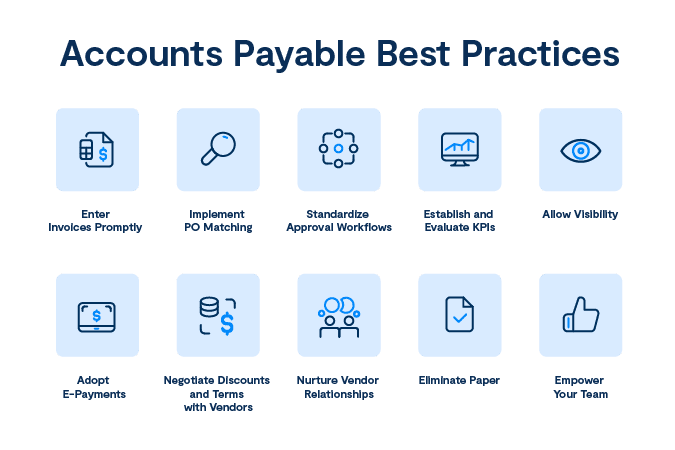Accounts payable (AP) is a critical function within any business. AP staff ensure the company’s bills are paid, and they create reporting that is essential for financial forecasting. To make sure your AP department is operating at an optimal level, consider implementing these accounts payable best practices in 2024.
1. Enter Invoices Promptly
Enter invoice data into your AP system without delay upon receipt. While some AP teams manually type this information in, others take advantage of invoice scanning software to save time and reduce errors.
Invoice scanning software eliminates manual data entry by using optical character recognition (OCR) technology to automate the invoice entry process. Some advanced systems also utilize machine learning to make the process more accurate.
Systems that provide full-service invoice management, combining advanced technology and professional indexers, offer top-of-the-line efficiency and accuracy.
2. Implement PO Matching
PO matching ensures the amount you are invoiced aligns with the amount agreed upon in your purchase order. It’s a way to flag billing errors, avoid overpayment and prevent fraud. To further increase accuracy, some AP teams use 3-way matching, which ensures the PO, invoice and sales receipt match.
PO matching can be tedious, but it’s an important part of accounts payable best practices that reduces risk within finance departments. Some AP solutions can automate PO matching, removing repetitive tasks from the plates of AP staff.
3. Standardize Approval Workflows
Create rules for invoice approval workflows and stick with them. For example, this may include requirements like director approval for invoices over a certain amount or a 5% tolerance level on PO mismatches.
Create a system for approvals that works for the individuals within your organization and prevents bottlenecks. And make sure the process meets the needs of your AP team, too. It’s a waste of time for them to run around the office hunting down approvers – and even more difficult now that the majority of workplaces have gone hybrid.
Some AP solutions can digitize the invoice approval process, automatically sending reminder emails to approvers and rerouting invoices when a stakeholder is out of the office.

4. Establish and Evaluate KPIs
Key performance indicators (KPIs) help any group measure performance and progress towards its goals. Within an AP department, KPIs can include invoice processing time, entry error rate and cost of processing per invoice. Understanding these metrics helps your AP team improve efficiency, pinpoint bottlenecks and create strategies for improvement.
It’s possible to track and calculate KPIs manually via spreadsheet, but some AP solutions offer business intelligence and reporting dashboards that deliver actionable performance insights at the click of a button.
5. Allow Visibility
Visibility supports better monitoring and control over financial processes, enabling timely and accurate payment processing. When all teammates can see where an invoice stands in real time – from receipt to payment – discrepancies, bottlenecks and errors can be promptly identified and addressed.
Centralized AP solutions enable digital visibility into invoice processing, allowing teammates to check on invoice status from anywhere at any time using any device. Visibility is an especially important feature for teams with remote workers or those that need staff to work between multiple locations.
6. Adopt E-Payments
The USPS has warned against putting checks in the mail, as the U.S. Treasury Department reported an 84% increase in check fraud in 2022. Not only does mailing checks put your payment at risk, but it adds days to your process.
E-payments offer a solution. They enable faster processing and reduced costs. Plus, they save your team the time of printing checks, having them signed, preparing an envelope and physically dropping them in the mail.
7. Negotiate Discounts and Terms with Vendors
By implementing accounts payable best practices, your team can have a significant impact on the organization’s bottom line. AP staff can work with vendors to negotiate opportunities for discounts and improved payment terms.
Using reporting tools within your AP system can help identify vendors for potential strategic partnerships or early payment discounts. Some AP software delivers automated reporting dashboards which make it simple to pull vendor history and other data.
8. Nurture Vendor Relationships
Vendor management is an important part of the AP process. Beyond simply paying bills on time, staying on top of contract terms, managing vendor data and compliance, and continually monitoring and assessing risk, AP teams can create win-win connections with vendors, working collaboratively to create positive impacts for both businesses.
9. Eliminate Paper
Dealing with paper invoices is a time drain for AP teams – from entering them into the system to filing and storing them. Transitioning to digital workflows is an accounts payable best practice that enhances efficiency, reduces the risk of human errors and expedites invoice processing.
This not only benefits vendors with timely payments but also enhances the department’s overall productivity. Moreover, a paperless approach minimizes operational costs associated with paper, storage and postage. It also supports environmental sustainability by reducing paper waste.
10. Empower Your Team
Automating AP processes frees time for your staff, empowering them to explore new opportunities and enhance their skill sets. With mundane, time-consuming tasks like data entry and approval routing automated, your team can redirect their efforts towards strategic initiatives.
With their free time, AP staff can focus on professional development and take on new responsibilities. Teammates may develop expertise in emerging technologies, financial analysis or vendor relationship management. An AP automation solution not only improves operational efficiency but also transforms your workforce into a more adaptable asset, prepared to tackle evolving challenges and identify business opportunities. Additionally, automated AP systems help attract and retain talent in a competitive job market.
Accounts Payable Best Practices: Positive Impacts for Your Department
Implementing accounts payable best practices can significantly enhance operational efficiency and financial processes, including invoice entry, PO matching and approval workflows. Digital solutions, including e-payments, help expedite the payment process, lower costs and enhance visibility. Managing KPIs and vendor relationships ensures the team’s work is consistently maximized.
Pivotal change comes from eliminating paper-based processes and transitioning to digital workflows, boosting productivity and reducing operational costs. Most importantly, accounts payable automation empowers staff by freeing them from repetitive tasks, allowing them to explore new opportunities and improving employee satisfaction and talent retention.
Accounts Payable Best Practices Examples
If you’re looking for accounts payable best practices examples, check out our customer success stories. You can discover how businesses like yours have increased efficiency, visibility, and control in their accounts payable processes with the AvidXchange accounts payable automation solution.



